SCE
Luna
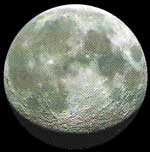
Luna (STSC)
Luna, commonly known simply as “the Moon,” was a Class-D world orbiting Earth.[4] By the late 24th century, more than 50 million people lived on the Moon.[3] The Talosians viewed several images about Earth’s Moon and programs to study and explore it while accessing the U.S.S. Enterprise NCC-1701‘s computer in 2254.[1] The Copernicus Ship Yards were located in orbit, with office facilities on the surface; the U.S.S. Hathaway NCC-2593 was built there.[2] Other points of interest on the Moon included Tranquility Base, where Apollo 11 landed in July 1969; as well as Lake Armstrong and New Berlin.[3] See also: Apollo program, Armstrong, Neil, Kennedy, John F., Lunar probe, Ranger probe.
References
Empok Nor
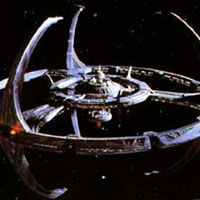
Nor-type station (DS9-401-402)
Cardassian space station nearly identical to one formerly known as Terok Nor, located in the Trivas System. The Cardassian military abandoned it in 2372. The next year, a salvage team from Deep Space Nine went on a mission to the derelict station in order to obtain needed parts. Unbeknownst to the team, three soldiers from the Cardassian First Battalion had been left behind in stasis, under the influence of a drug that made them extremely aggressive and paranoid.[1]
References
Earth
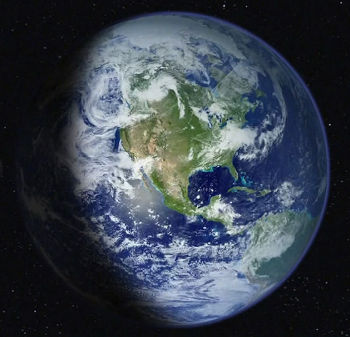
Earth (TOS-21)

Earth (ENT-78)
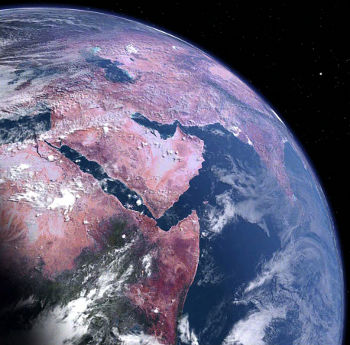
Earth (TOS-55)
Class-M. Earth is the third planet in the Sol System[1] in Sector 001[7] and homeworld of Humans. In 2254, the Talosians viewed an image of the Sol System and many images of Earth’s history while accessing the U.S.S. Enterprise NCC-1701‘s computer.[1] Earth became one of the founding members of the United Federation of Planets in 2161,[15] following the Romulan War,[6] and served as that body’s capital.[5] Starfleet Command and Starfleet Academy were based in San Francisco,[2, 3] while the offices of the Federation President[9] and the Federation Council chamber were located in Paris.[22] The planet hosted several advanced orbital habitats,[2] Starfleet spacedocks,[4] and satellite networks, including Federation communications networks.[12]
› Continue reading
Deep Space Nine

Deep Space Nine (DS9-401-402)
Formerly a Cardassian mining facility orbiting Bajor called Terok Nor, the station was redesignated Deep Space Nine when it came under Federation control following the end of the Cardassian Occupation of Bajor in 2369. At the behest of the Bajoran Provisional Government, Starfleet administered the facility. Shortly after the arrival of the station’s new Starfleet crew, however, a stable, artificial wormhole was discovered in the Bajor System‘s Denorios Belt. The station was moved to a new position near the terminus of the wormhole, and it quickly became a focal point for political and military intrigue, as well as one of the most strategic locations in the quadrant.[1]
References
- 1. “Emissary.” Star Trek: Deep Space Nine, Episodes 401-402. Television. 4 January 1993.
Planet, Class-M

Earth (ENT-78)
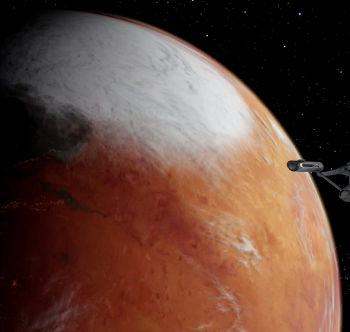
Vulcan (TOS-34)
Terrestrial. Age ranged from 3-10 billion years. Diameter was 10,000 to 15,000 km. Typically located in the Ecosphere of a planetary system. Surface water was abundant; if water or ice covered more than 80% of the surface, the planet was considered Class O or Class P. Atmosphere was primarily primarily nitrogen, oxygen, and trace elements. Contained extensive vegitation and animal life.[8] Capable of supporting carbon-based, humanoid life.[1]
The designation apparently stemmed from the Vulcan word “Minshara,” which was used to designate planets capable of supporting life.[7] Class-M planets could vary widely in color, cloud cover, and overall appearance. Most Class-M planets were characterized by a relatively thin, tectonically active crust floating on a molten rock mantle, which in turn surrounded a liquid metal outer core and a solid inner core composed of metal crystals.
› Continue reading
Planet, Class-J
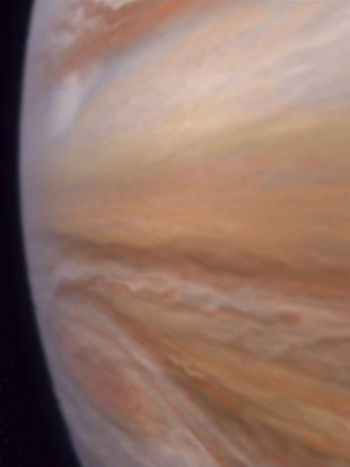
Jupiter (ENT-50)
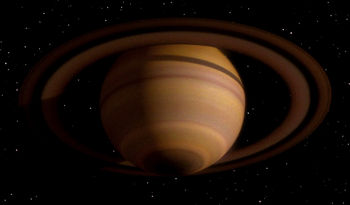
Saturn (TNG-101-102)
Gas giant. Age ranges from 2-10 billion years. Diameter is 50,000 to 140,000 km. Typically located in the Cold Zone of a planetary system. Surface radiates some heat and is tenuous and comprised of gaseous hydrogen and hydrogen compounds, atmospheric zones vary in temperature, pressure and composition. May contain hydrocarbon-based life forms.[1]
References
- 1. Star Trek Star Charts. Book. Pocket Books. October 2002.
Quadrants

One quarter of the galaxy. The four quadrants were designated by the Greek letters Alpha, Beta, Gamma, and Delta, and were arbitrarily divided using Earth as a reference point. As a result, Earth, and the sector it occupied, fell in the Alpha Quadrant, while the sector containing Vulcan and Andoria fell in the Beta Quadrant. The Gamma and Delta Quadrants remained largely unexplored through the 25th century, though knowledge of those regions was greatly increased thanks to the Bajoran wormhole and the U.S.S. Voyager NCC-74656, respectively.[1]
› Continue reading
Milky Way Galaxy

Milky Way (TOS-01)
The Milky Way was a spiral galaxy approximately 100 thousand light years across, divided into four quadrants, designated by the Greek letters Alpha, Beta, Gamma, and Delta, and were arbitrarily divided using Earth as a reference point. As a result, Earth, and the Sol Sector, fell in the Alpha Quadrant, while the Vulcan and Andorian Sectors fell in the Beta Quadrant. The Gamma and Delta Quadrants remained largely unexplored by the early 25th century, though knowledge of those regions was greatly increased thanks to the Bajoran wormhole and the U.S.S. Voyager NCC-74656, respectively.[3] The galaxy was surrounded by a nearly-impenetrable energy field, dubbed the Galactic Barrier, with unpredictable neurogenic properties.[1, 3] Likewise, the core of the galaxy is surrounded by a distinct but related field, dubbed the Great Barrier.[2, 3]
› Continue reading
Asteroid

Asteroid (TOS-58)
Small celestial body composed of rock and metal, typically much smaller than a planet, often irregularly shaped. Asteroids often occurred in orbital belts within a star system, sometimes the debris remaining from the formation of that system, other times the fragments remaining from the disintegration of a planet. Larger asteroids were sometimes called planetoids.
In 2267, the U.S.S. Enterprise NCC-1701 attempted to divert an asteroid that was on a collision course with an inhabited planet.[1] A Type-C asteroid crashed into an unpopulated continent of Penthara IV in 2367, threatening an ecological disaster until the U.S.S. Enterprise NCC-170-D helped dispel its dust cloud.[2] Another asteroid from the Pelloris Field threatened Tessen III with the same type of destruction in 2368 before it was vaporized by the same starship. Its nitrium alloy core prevented a tractor beam lock, and it was undamaged when hit by photon torpedoes. It was later discovered to be the home of metal parasites.[3]
› Continue reading
Humans
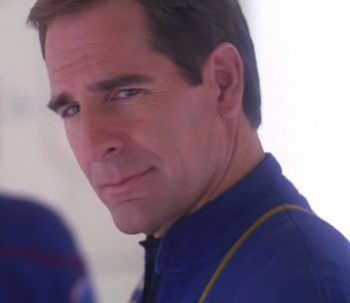
Jonathan Archer (ENT-31)
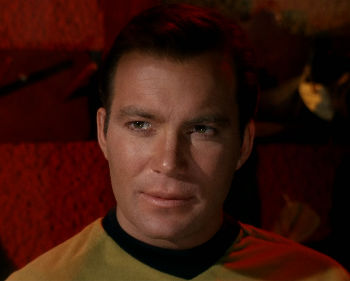
James T. Kirk (TOS-05)
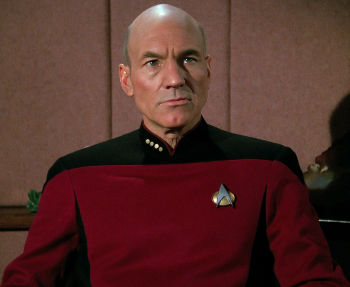
Jean-Luc Picard (TNG-165)
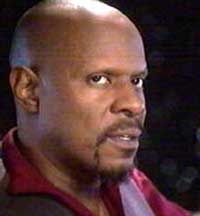
Benjamin Sisko (DS9-541)
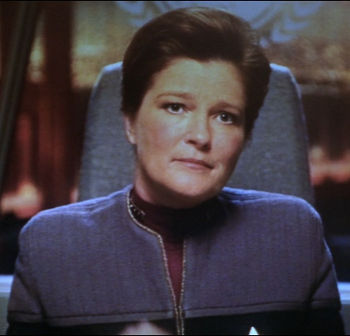
Kathryn Janeway (ST-10)
Species originating on Earth. According to the Talosians in the 2250s, “The customs and history of [Humans] show[s] a unique hatred of captivity. Even when it’s pleasant and benevolent, [they] prefer death. This makes [them] too violent and dangerous a species for [the Talosians’] needs.” The Talosians had scanned the U.S.S. Enterprise NCC-1701‘s databanks, and had gleaned quite a bit of information about Human history.[1]
Notable Humans
References
- 1. “The Cage.” Star Trek, Episode 00. Television. 1965 (Unaired).
- 2. “Where No Man Has Gone Before.” Star Trek, Episode 01. Television. 22 September 1966.
- 3. “Encounter at Farpoint.” Star Trek: The Next Generation, Episodes 101-102. Television. 28 September 1987.
- 4. “Emissary.” Star Trek: Deep Space Nine, Episodes 401-402. Television. 4 January 1993.
- 5. “Caretaker.” Star Trek: Voyager, Episodes 101-102. Television. 16 January 1995.
- 6. “Broken Bow.” Star Trek: Enterprise, Episodes 01-02. Television. 26 September 2001.
Categories
- Animated Series (60)
- Articles (28)
- Books (447)
- Cast & Crew (79)
- Comics (22)
- DS9 (328)
- Early Voyages (125)
- Education (5)
- Enterprise (373)
- Excelsior (36)
- Food (19)
- Games (223)
- Klingon (70)
- Library (1,543)
- Logs (593)
- Lost Era (55)
- Medicine (18)
- Merrimac (1)
- Mirror (35)
- Miscellaneous (13)
- New Frontier (54)
- Next Generation (635)
- Original Series (681)
- Personnel (436)
- Places (369)
- Politics (12)
- Recreation (10)
- SCE (41)
- Science (1)
- Shatnerverse (9)
- Ships (455)
- Site Updates (98)
- Starfleet Academy (86)
- Stargazer (42)
- STO (61)
- Technology (45)
- Titan (59)
- To Boldly Go (1)
- TV/Film (214)
- Uncategorized (4)
- Vanguard (76)
- Voyager (236)
- Weapons (27)
- Xenology (54)